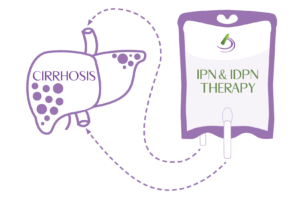
There is a persistent myth in healthcare that patients with cirrhosis, or advanced liver disease, should restrict protein intake to help manage their disease. This stems from decades old research that has since been disproven. In fact, people with advanced liver disease are at increased risk of protein-energy malnutrition and every effort should be made to ensure these patients meet a goal of 1.2g-1.5g/kg ABW/day.
For patients with comorbid liver disease and end-stage renal disease on dialysis, meeting protein and energy goals may be especially challenging due to overlapping side effects like loss of appetite, nausea, and fatigue. However, dialysis dietitians have a unique resource for these patients in the form of intradialytic parenteral nutrition (IDPN) for hemodialysis and intraperitoneal nutrition (IPN) for peritoneal dialysis. These therapies can boost protein availability without adding more burden onto the patient.
Here, Chelsea Moore, RDN, LD discusses how she used IDPN therapy to support her patient in meeting their nutrition goals:
When I worked in the dialysis clinics, IDPN wasn’t heavily used in my area. I had very little understanding of how the product worked in comparison to TPN. Through working with the pharmacy and participating in CEU webinars, I learned that this product, IDPN, could be used in a variety of comorbid conditions for the dialysis patient. My greatest success was when using IDPN with an ESRD patient with End Stage Liver Disease. The patient had severe ascites and was receiving paracentesis twice a week to drain the additional fluid from his belly. His albumin was in the low 2.0 range.
Ascites is a result of portal hypertension. The increased hydrostatic pressure associated with portal hypertension along with low albumin leads to accumulation of fluid in the abdominal cavity. Albumin provides 80% of oncotic pressure in extracellular fluid, when levels are low it results in increase vascular permeability which makes it easy for fluid to seep into places where it does not belong.
Chelsea continues:
I applied for him to receive IDPN, having just been educated on Fluid Management in Dialysis. After this patient was on IDPN, not only did his albumin start to improve, but we were able to decrease his need for paracentesis to once a week as a result of using the therapy.
Liver disease impairs protein synthesis, but it does not prevent it all together. Cirrhosis is considered a state of accelerated starvation. This means supplying adequate protein and calories regularly throughout the day is crucial to stay ahead of the catabolic demand of the disease. By providing IDPN therapy, Chelsea ensures her patient was receiving adequate nutrients to shift from a catabolic to anabolic state and synthesize important body proteins.
Chelsea concluded:
Although the patient was terminal, he ended up living for an additional 6 months. This patient would tell me how much better he was feeling and that he was grateful for not having to have the fluid drained from his belly but once a week. This patient always stuck with me, as he was a vocal advocate for my other patients who were scared of trying “one more medication.”
Improving nutrition status for patients can result in better quality of life, improved symptom management, and reduced healthcare burden. If you would like to learn more about Patient Care America’s IDPN and IPN therapies, check out these resources:
- IDPN Fact and Fiction recorded webinar
- Clinician Portal for clinician and patient handouts
References
- European Association For The Study Of The Liver. (2019). EASL Clinical Practice Guidelines on nutrition in chronic liver disease. Journal of hepatology, 70(1), 172-193.
- Sharma, A., & Nagalli, S. (2021). Chronic liver disease. In StatPearls [Internet]. StatPearls Publishing.
- Kumar, R., Priyadarshi, R. N., & Anand, U. (2021). Chronic renal dysfunction in cirrhosis: A new frontier in hepatology. World journal of gastroenterology, 27(11), 990–1005. https://doi.org/10.3748/wjg.v27.i11.990
